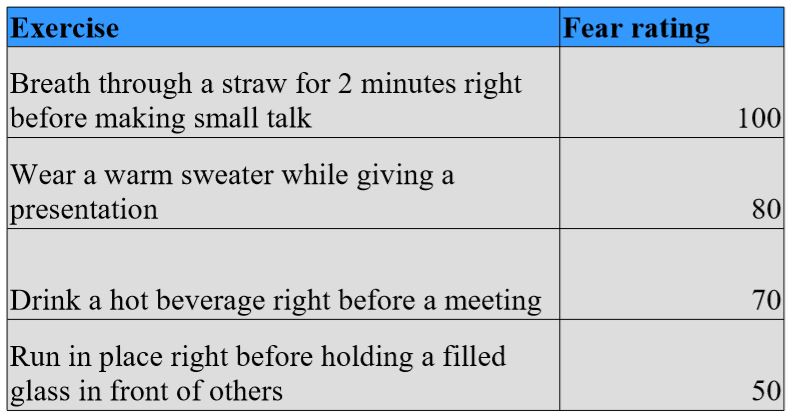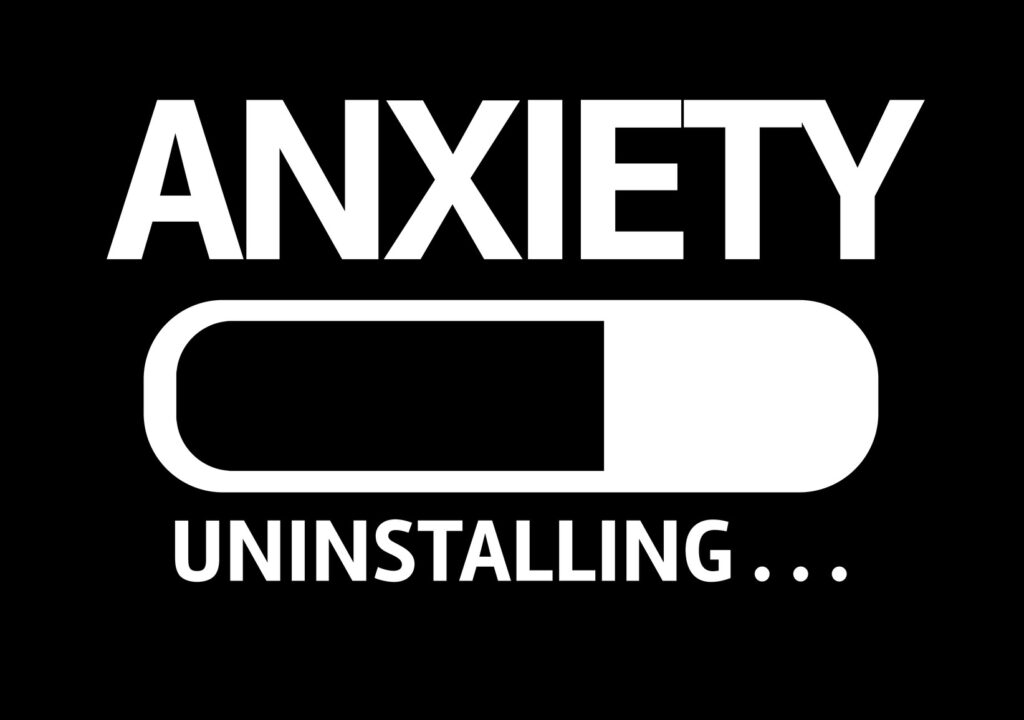Many people with social anxiety fear that people will notice that we are anxious, and this brings about all kinds of physical sensations. We learn to really fear the physical sensations (blushing, sweating, rapid heart rate, dizziness) that panic and anxiety can bring.
If that’s you, you may benefit from exposing yourself to those sensations on purpose. Again, are you willing to undergo some short term discomfort in order to benefit over the long term? I know I was fed up enough with it to do so. What about you?
If you are afraid of experiencing breathlessness, dizziness, shaking, blushing, sweating, or rapid heart rate and you are afraid of experiencing them in front of others, these exposure exercises can be beneficial.
This type of exposure is called interoceptive exposure – intentional exposure to internal physical sensations. I remember being anxious in certain situations and somehow that developed into blushing and feeling anxious at the same time. Eventually, I feared the blushing above all else. The anxiety + physical sensation (that other people may see) becomes a vicious cycle.
Before you know it, you’re overwhelmed with physical feelings, anxious thoughts, and anxious behaviors and you don’t know how to overcome it because it’s just so much all at once – see three components of social anxiety. When you break it down into its three components, it become much more manageable.
We covered anxious thinking and behavior already, now we will cover some exercises you can do to overcome your uncomfortable sensations.
When you physical sensations like shaking, sweating, and blushing reinforces your belief that these physical sensations are dangerous. These sensations may be uncomfortable, but they are not dangerous. By exposing yourself to feared sensations, you can learn that experiencing these sensations isn’t as frightening as you’re making it out to be.
To repeat, when you experience the sensation on purpose and repeatedly, you will see that it is not life threatening. You may feel a bit of discomfort, but it’ll be fine – no reason to spiral out of control when it happens.
Key point here is to remember that the problem isn’t your physical sensations, the problem is how you feel about those physical sensations. Your beliefs about the consequences of having these physical sensations is the real issue. So, we will want to explore that.
Practice In A Controlled Setting
To start, you will want to experience these physical sensations in a controlled and predictable way. This sense of control will help you to not feel overwhelmed. Once you get a good handle on the physical sensation and learn that it is not dangerous, you will be able to experience those sensations in some future social situation (even if you didn’t plan on them happening) without flying off the handle.
Additionally, you will want to expose yourself to these physical sensations often and for long periods of time until you learn that it’s not dangerous to feel that way. Continue combating your anxious thoughts before, during, and after your exposure practice.
Next, you want to identify what types of physical sensations make you anxious. Refer to your self-assessment.
Next,
Plan Your Exposures
Here is a list of physical sensations and exercises you can do to induce those sensations:

If you’re healthy, these exercises are safe, but if in doubt, check with your doctor before doing any of these exercises.
Do them in a safe environment, like your house. When you feel like you’re starting to feel ok with those sensations, do your physical sensation exercise right before you go into in a social situation.
Exposure To Uncomfortable Exposures In A Social Setting
You may think this will be difficult to do, but now that you are armed with strategies to combat your anxious thinking, this will be easier than you think. Use anxious thinking strategies like rational coping statements, challenging catastrophic thinking, examine the evidence, remember your strengths, and so on. Do what works for you.
What you will learn from inducing these physical sensations is that your fears about them are unfounded. You will also learn that if it does happen in a social situation that you can control it and the consequences are not as bad as you imagined them to be.
When you allow yourself to be anxious in front of others you will learn that those feelings are ok and you won’t be so scared of experiencing them in front of others. You won’t care if other people notice your symptoms which will in turn, stop those symptoms from manifesting. When your symptoms are reduced, your social anxiety will also be reduced.
Step By Step Guide To Symptom Exposure
1 – Symptom induction testing
Determine which symptoms do you fear and which exercises will work best for you. Try it at home and see if it’s similar to how you feel in social situations.
2 – Develop symptom exposure hierarchy
Use the exercises you want and note the symptoms you get. Note how much fear you’re feeling. Make a hierarchy for both non social situations and for social situations. If you don’t fear your physical sensations like sweating, blushing, and shaking in non-social situations, then just make a hierarchy for social situations.
See symptom induction testing form from Oxford Clinical Psychology website
Here is an example of symptom exposure hierarchy in social situations:

3 – Practice in non social situations
For the symptoms that you fear arising in social situations, practice them at home first. You want to be familiar and comfortable with the feeling before bring it forward in social situations. Make them challenging but not overwhelming – that’s why the use of the exposure hierarchy is so important.
4 – Practice symptom exposure in social situations
Finally, you will practice symptom exposure in social situations. Doing so will teach you that your anxious predictions are untrue.
Lastly, keep a symptom exposure journal. Keep the journal to note how you are feeling before, during, and after a symptom exposure practice. Also use it to identify and challenge any anxious thoughts you have before, during, or after the exposure.
Next: Now that you have learned to understand your social anxiety, identify and correct anxious thinking and behavior, and exposed yourself to social situations, you may want to work on improving your social skills.
Recommended reading: Communicate more effectively (coming soon).
